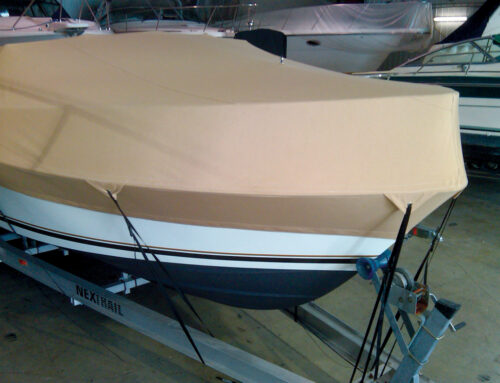Sitting pretty
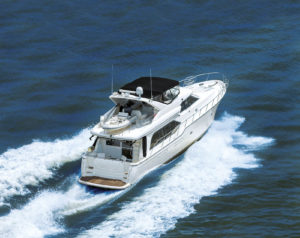 With access to better fabrics and accessories, fabricators are crafting boat cushions that look great and perform well.
With access to better fabrics and accessories, fabricators are crafting boat cushions that look great and perform well.
Boat cushion design is leaving the Dark Ages, where basic vinyls, color and patterns have reigned supreme. “Over the past 10 years, fashion and design have become more prevalent in the marine industry,” says Patty Mastrandrea, a fabricator with Custom Marine Canvas in Noank, Conn. “While all cushions are utilitarian, they tend to look more like home interiors, with more interesting fabrics, weaves and prints to work with.”
Additional choices spell good news for the marine fabrication industry. “The custom shops and upholstery shops have benefited because the fabric selection is bigger for their customer base,” says Krisha Plauché, principal designer at Onboard Interiors in Marblehead, Mass.
Right-angled edges are going to the wayside in some applications as boat builders are using more PVC board in place of marine plywood, enabling more curved sections for a European aesthetic, according to Carol Racine, co-owner of Racine Design Inc. in Jacksonville, Fla. She notes that new fastening systems also help create a sleeker look.
One thing that hasn’t changed, however: A boat cushion is only as good as its material selection, design and construction.
Take it outside
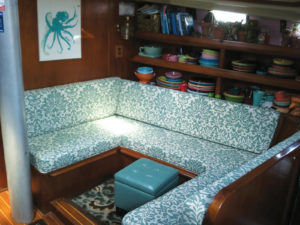
When it comes to color, texture and patterns, boat owners are willing to expand their horizons. “I have noticed that patterns don’t scare people like they used to,” says Krisha Plauche, principal designer at Onboard Interiors.
Outdoor boat cushions have to stand up to the sun, wind, rain, saltwater and crew activity. “For exteriors, the driving force is performance and durability,” says Rebecca Kennedy of Kennedy Custom Upholstery in Ocean City, N.J. “You want to specify the right materials for the job.”
Marine-grade vinyl remains a popular choice for exterior cushions. “Exterior vinyl selections are abundant in patterns and textures resembling leather to linen, and manufacturers incorporate silver-ion technology to ensure durability,” says Terri Madden, owner of Sand Sea and Air Interiors Inc. in San Juan, Puerto Rico. “Suppliers also offer foam backing in various densities on vinyl and suede for custom projects, such as padded wall panels and seating.”
Because an all-vinyl cushion traps and holds air, ventilation release is important. “This can be done with mesh bands, grommets or ventilators in the back of this style of cushion,” Madden explains.
Some boat owners seek alternatives to vinyl for exterior cushions. Outdoor solution-dyed acrylics and mesh are suitable for certain applications. “The customer must understand that there is more care involved in a cushion that is covered with something other than vinyl,” Racine notes. “While vinyl is water repellant and easy to wipe clean, the acrylic is not so much.”
Although Plauché still receives requests for vinyl upholstery, “it seems to be phasing out in interiors and used for smaller utility-type vessels in exterior seating.”
Appropriate structure of an exterior cushion goes beyond the fabric selection. Madden, for one, says she fabricates using stainless-steel staples for projects mounted on PVC board and PTFE (polytetrafluorethylene) thread for solar degradation on projects exposed to salty conditions.
Additionally, seam placement is an important consideration for exterior cushions to prevent water ponding and to allow for water run-off. Racine also emphasizes the importance of creating a design that doesn’t hold water. “Deep tufting just makes little pools and soaks the foam inside,” she says.
What goes inside the cushion is just as important as what covers it. “We like to put either reticulated foam or closed-cell foam or a combination of the two in the cushion,” Mastrandrea says. “The reticulated foam allows water to run right through it without soaking in and holding onto it. The closed-cell foam does not allow water to penetrate it at all.”
The bottoms of the exterior cushions Mastrandrea fabricates are typically mesh with a zipper in it. “This allows for water to escape the inside and air to flow through it,” she explains. “If the cushion is flipable, we will use the fabric on both sides and put a zipper in a mesh boxing.”
Interior considerations
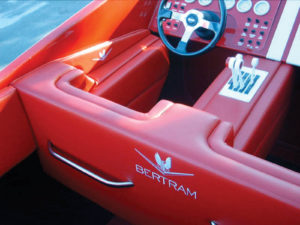
“The customer must understand that there is more care involved in a cushion that is covered with something other than vinyl,” notes Carole Racine of Racine Design Inc. in Jacksonville, Fla.
The range of interior cushion fabrics includes acrylics, polyesters and polyester blends, and other indoor/outdoor fabrics. “Interior cushions are more about comfort and aesthetics,” Kennedy says. “Here, if you use vinyl, it’s something that has a high-end leather look for a salon sofa or a dinette.”
Plauché says ultra suede is a staple in her shop’s library. “It’s so durable, breathable and cleans like a dream,” she says. “It’s one of the best choices for interior spaces and such a good decision for customers with kids and pets.”
Indoor/outdoor fabric manufacturers continue to expand and refine their offerings, leading to more choices than ever for boat cushions. “Designers such as Ralph Lauren, Kravet and Perennials offer specialty weaves, textures and patterns,” Madden says. “Woven fabrics can be custom printed for both interior and exterior applications at an additional price.”
She also credits Sunbrella’s acrylic yarn availability to designers a few years ago for “the explosion of possibilities for upholstery projects.”
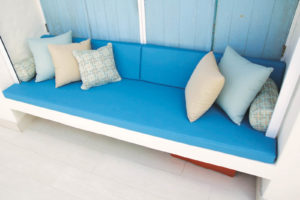
Because all-vinyl cushions trap and hold air, ventilation release is important, says Terri Madden of Sea Sand and Air Interiors of San Juan, Puerto Rico. “This can be done with mesh bands, grommets or ventilators in the back of this style of cushion.”
Plauché reports a new innovative fabric in her shop called Solar, a luminescent printed acrylic fabric from Extex. The material’s pattern, inspired by galaxies and star systems, is printed using a “glow-in-the-dark” ink containing photoluminescent particles that absorb sunlight when exposed for five to 30 minutes. When the surroundings go dark, the stored light is emitted over several hours. The base fabric features a permanent stain- and water-repellent finish.
No matter what fabric the customer selects for interior cushions, “make absolutely sure that it is colorfast,” Racine advises. “You don’t want the print on your salon cushions transferring to your guest’s expensive bathing suit, or the other way around.”
If the boat has an overhead hatch that allows light through, Racine also will recommend a snap-on interior shade. “The UV that comes through the hatch will sun rot the cushion covers,” she says.
Within interior cushions, Mastrandrea uses a polyfoam and sometimes a memory topper. The most common thicknesses are 2, 3, and 4 inches, but she notes that these choices are all dependent on the space available in the boat and customer preference.
“The customer has the opportunity to ‘build’ their own foam insert by choosing foam densities, layers and thicknesses,” Mastrandrea says. “If the cushion is not flipable, we use a lighter, breathable bottom fabric. This saves the customer money and allows us to put in a big zipper for stuffing.”
Certain products demonstrate properties that are suitable for both interior and exterior boat cushions. “A hyper-vent mesh product is available to elevate and aerate interior boat cushions, as well as utilizing it for exterior applications where water drainage is an issue,” Madden says.
Aesthetics evolution
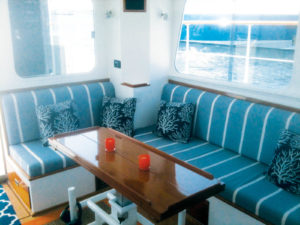
“Over the past 10 years, fashion and design have become more prevalent in the marine industry,” says Patty Mastrandrea, a fabricator with Custom Marine Canvas in Noank, Conn. “While all cushions are utilitarian, they tend to look more like home interiors, with more interesting fabrics, weaves and prints to work with.”
When it comes to color, texture and patterns, boat owners are willing to expand their horizons. “I have noticed that patterns don’t scare people like they used to,” Plauché says. “Larger designs such as the hourglass design, which reminds one of waves, are really fun.”
For exterior applications, Madden has found that color and textures have replaced classic white. “Boat manufacturers incorporate tones of colors on single cushions, some with quilted inserts and piping accents,” she says. “We currently have a request to incorporate five fabric patterns on just one rectangular cushion.”
Tasteful nautical patterns and colorations remain a favorite among boaters. On a recent project, Madden implemented a white-and-navy scheme with a coral hue accent in lieu of the traditional red, “a twist that the customer loved.”
But for every boat owner who is willing to experiment with design, there’s another who prefers a classic approach. “For interiors, an all-neutral scheme seems to prevail,” Kennedy says. “I see a lot of layering with shades of tan and brown because it creates a serene monochromatic palette with the woodwork.”
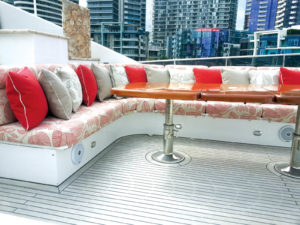 When working with all one color, Kennedy advises designers to vary the textures to keep the eye interested. “You can introduce pops of color via throw pillows for maximum impact,” she says. “For accent colors, I find that slate blue and burnt orange are pretty popular now.”
When working with all one color, Kennedy advises designers to vary the textures to keep the eye interested. “You can introduce pops of color via throw pillows for maximum impact,” she says. “For accent colors, I find that slate blue and burnt orange are pretty popular now.”
Fabricators also report that stripes remain a go-to favorite, although the traditional navy blue-and-white stripe combination “has been harder and harder to find in the marine fabric world over the past several years,” Mastrandrea says.
The longevity of a boat cushion comes down to how well the boat owner takes care of it. “I have seen upholstery 40 years old that looks like the day it was made,” Racine says. “I have also seen upholstery three years old that needs to be replaced. It boils down to the three Cs: cleaning, conditioning and covering. If users do those three things properly, their upholstery will remain good looking and functional.”
A re-upholstery project provides fabricators a perfect opportunity to introduce customers to the newest fabrics and designs for boat cushions. And boat owners seem to be listening.
“People who are enjoying the luxurious yachting lifestyle are usually willing to spend the money to have all the right accoutrements onboard,” Plauché says.
Holly O’Dell is a freelance writer basedin Joshua Tree, Calif.
Attachment issues
A discussion on whether a cushion will be loose or attached should take place during preliminary project meetings with the customer. Patty Mastrandrea of Custom Marine Canvas uses various methods of permanent and nonpermanent attachment to the boat. “Snap flaps, snap tabs, Velcro and boltrope are all possibilities depending on the construction of the boat and the customers’ preference,” she says. “Some cushions are wrapped and stapled to a board, which is then bolted to the boat.”
Many of the indoor cushions sit inside the boat’s fiddle, which may be enough to keep a cushion in place. The backs, however, need some extra support system to keep them in place.
“We use a snap or Velcro flap, usually along the top backside of the cushion and sometimes along the bottom,” Mastrandrea explains. “We have also used a non-skid pad between seat and cushion to keep them from slipping.”
She notes that this approach is more useful in sailboats, as they tend to heel to one side or the other when under sail. “If a cushion needs Velcro on the bottom to keep it in place, it cannot be flipable,” she adds, “so this option is discussed with the customer.”
 TEXTILES.ORG
TEXTILES.ORG 




